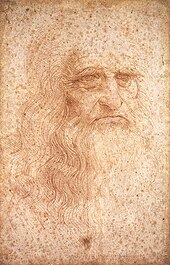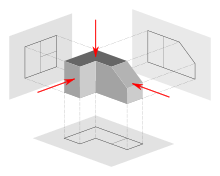Graphics
Graphics(fromAncient Greekγραφικός(graphikós)'pertaining to drawing, painting, writing, etc.') arevisualimagesordesignson some surface, such as a wall,canvas,screen,paper,or stone, to inform,illustrate,or entertain. In contemporary usage, it includes a pictorial representation of data, as in design and manufacture, in typesetting and the graphic arts, and in educational and recreationalsoftware.Images that are generated by a computer are calledcomputer graphics.
Examples arephotographs,drawings,line art,mathematical graphs,line graphs,charts,diagrams,typography,numbers,symbols,geometricdesigns,maps,engineering drawings,or otherimages.Graphics often combinetext,illustration,andcolor.Graphic designmay consist of the deliberate selection, creation, or arrangement oftypographyalone, as in a brochure, flyer, poster, web site, or book without any other element. The objective can be clarity or effective communication, association with other cultural elements, or merely the creation of a distinctive style.
Graphics can be functional or artistic. The latter can be a recorded version, such as aphotograph,or an interpretation by a scientist to highlight essential features, or an artist, in which case the distinction with imaginary graphics may become blurred. It can also be used for architecture.
History[edit]
The earliest graphics known toanthropologistsstudying prehistoric periods arecave paintingsand markings on boulders, bone, ivory, and antlers, which were created during theUpper Palaeolithicperiod from 40,000 to 10,000B.C.or earlier. Many of these were found to record astronomical, seasonal, and chronological details. Some of the earliest graphics and drawings are known to themodern world,from almost 6,000 years ago, are that of engravedstone tabletsand ceramiccylinder seals,marking the beginning of the historical periods and the keeping of records for accounting and inventory purposes. Records from Egypt predate these andpapyruswas used by theEgyptiansas a material on which to plan the building ofpyramids;they also used slabs oflimestoneandwood.From 600 to 250 BC, the Greeks played a major role ingeometry.They used graphics to represent their mathematical theories such as the Circle Theorem and thePythagorean theorem.
In art, "graphics" is often used to distinguish work in a monotone and made up of lines, as opposed topainting.
Drawing[edit]

Drawinggenerally involves making marks on a surface by applying pressure from a tool or moving a tool across a surface. In which a tool is always used as if there were no tools it would be art. Graphical drawing is an instrumental guided drawing.
Printmaking[edit]
Woodblock printing,including images is first seen inChinaafterpaperwas invented (about A.D. 105). In the West, the main techniques have beenwoodcut,engravingandetching,but there are many others.
Etching[edit]
Etching is anintagliomethod ofprintmakingin which the image is incised into the surface of a metal plate using an acid. The acid eats the metal, leaving behind roughened areas, or, if the surface exposed to the acid is very thin, burning a line into the plate. The use of the process in printmaking is believed to have been invented byDaniel Hopfer(c. 1470–1536) ofAugsburg,Germany,who decorated armour in this way.
Etching is also used in the manufacturing of printed circuit boards and semiconductor devices.
Line art[edit]
Line art is a rather non-specific term sometimes used for any image that consists of distinct straight and curved lines placed against a (usually plain) background, without gradations inshade(darkness) orhue(color) to represent two-dimensional or three-dimensional objects. Line art is usually monochromatic, although lines may be of different colors.
Illustration[edit]

An illustration is avisualrepresentationsuch as adrawing,painting,photographor other work ofartthat stresses the subject more than form. The aim of anillustrationis to elucidate or decorate a story, poem or piece of textual information (such as anewspaperarticle), traditionally by providing a visual representation of something described in the text. Theeditorial cartoon,also known as a political cartoon, is an illustration containing a political or social message.
Illustrationscan be used to display a wide range of subject matter and serve a variety of functions, such as:
- giving faces to characters in a story
- displaying a number of examples of an item described in an academic textbook (e.g. ATypology)
- visualizing step-wise sets of instructions in a technical manual
- communicating subtle thematic tone in a narrative
- linking brands to the ideas of human expression, individuality, and creativity
- making a reader laugh or smile
- for fun (to make laugh) funny
Graphs[edit]
Agraphorchartis a graphic that representstabularornumericdata. Charts are often used to make it easier to understand large quantities of data and the relationships between different parts of the data.
Diagrams[edit]
A diagram is a simplified and structured visual representation of concepts, ideas, constructions, relations, statistical data, etc., used to visualize and clarify the topic.
Symbols[edit]
A symbol, in its basic sense, is a representation of aconceptor quantity; i.e., anidea,object,concept,quality,etc. In more psychological and philosophical terms, all concepts are symbolic in nature, and representations for these concepts are simply token artifacts that areallegoricalto (but do not directly codify) a symbolicmeaning,orsymbolism.
Maps[edit]
A map is a simplified depiction of aspace,a navigational aid which highlights relations between objects within that space. Usually, a map is atwo-dimensional, geometrically accurate representationof athree-dimensional space.
One of the first 'modern' maps was made byWaldseemüller.
Photography[edit]

One difference between photography and other forms of graphics is that a photographer, in principle, just records a single moment in reality, with seemingly no interpretation. However, a photographer can choose thefield of viewand angle, and may also use other techniques, such as variouslensesto choose the view orfiltersto change the colors. In recent times,digital photographyhas opened the way to an infinite number of fast, but strong, manipulations. Even in the early days of photography, there was controversy over photographs of enacted scenes that were presented as 'real life' (especially inwar photography,where it can be very difficult to record the original events). Shifting the viewer's eyes ever so slightly with simple pinpricks in the negative could have a dramatic effect.
The choice of the field of view can have a strong effect, effectively 'censoring out' other parts of the scene, accomplished by cropping them out or simply not including them in the photograph. This even touches on the philosophical question of what reality is. The human brain processes information based on previous experience, making us see what we want to see or what we were taught to see. Photography does the same, although the photographer interprets the scene for their viewer.
Engineering drawings[edit]

An engineering drawing is a type ofdrawingand is technical in nature, used to fully and clearly define requirements forengineereditems. It is usually created in accordance with standardized conventions for layout, nomenclature, interpretation, appearance (such astypefacesand line styles), size, etc.
Computer graphics[edit]
There are two types of computer graphics:raster graphics,where each pixel is separately defined (as in a digital photograph), andvector graphics,where mathematical formulas are used to draw lines and shapes, which are then interpreted at the viewer's end to produce the graphic. Using vectors results in infinitely sharp graphics and often smallerfiles,but, when complex, like vectors take time to render and may have larger file sizes than a raster equivalent.
In 1950, the first computer-driven display was attached to MIT'sWhirlwind Icomputer to generate simple pictures. This was followed byMIT'sTX-0andTX-2,interactive computingwhich increased interest incomputer graphicsduring the late 1950s. In 1962,Ivan SutherlandinventedSketchpad,an innovative program that influenced alternative forms of interaction with computers.
In the mid-1960s, large computer graphics research projects were begun atMIT,General Motors,Bell Labs,andLockheed Corporation.Douglas T. RossofMITdeveloped an advanced compiler language for graphics programming.S.A.Coons,also at MIT, and J. C. Ferguson atBoeing,began work in sculptured surfaces.GMdeveloped theirDAC-1system, and other companies, such asDouglas,Lockheed,andMcDonnell,also made significant developments. In 1968,ray tracingwas first described by Arthur Appel of the IBM Research Center, Yorktown Heights, N.Y.[1]
During the late 1970s,home computersbecame more powerful, capable of drawing both basic and complex shapes and designs. In the 1980s, artists and graphic designers began to see the personal computer as a serious design tool, one that could save time and draw more accurately than other methods.
3D computer graphicsbegan being used in video games in the 1970s withSpasimfor thePLATOsystem in 1974 andFS1 Flight Simulatorin 1979.Atari, Inc.'sBattlezone(1980) exposed 3D graphics to a wide audience. Other wireframe and flat-shaded 3D games appeared throughout the 1980s.Ultima Underworld: The Stygian Abyss(1992) was one of the first major video games with texture-mapped polygons.
Computer systems dating from the 1980s and onwards often use agraphical user interface(GUI) to present data and information with symbols, icons, and pictures, rather than text.3D computer graphicsand creation tools became more accessible to video game and film developers in the late 1980s withSGIcomputers, which were later used to create some of the first fully computer-generatedshort filmsatPixar.
3D graphicsbecame more popular in the 1990s in video games,multimedia,andanimation.In 1995,Toy Story,the first full-length computer-generated animation film, was released in cinemas. Since then, computer graphics have become more accurate and detailed, due to more advanced computers and better3D modelingsoftware applications, such asMaya,3D Studio Max,andCinema 4D.Consumer-level 3D graphics acceleration hardware became common inIBM PC compatiblesnear the end of the decade.
Another use of computer graphics isscreensavers,originally intended to prevent the layout of much-usedGUIsfrom 'burning into' the computer screen. They have since evolved into true pieces of art, their practical purpose obsolete; modern screens are not susceptible to such artifacts.
Web graphics[edit]
In the 1990s, Internet speeds increased, and Internet browsers capable of viewing images were released, the first beingMosaic.Websites began to use theGIFformat to display small graphics, such as banners, advertisements, and navigation buttons, on web pages. Modernweb browserscan now displayJPEG,PNGand increasingly,SVGimages in addition toGIFson web pages.SVG,and to some extentVML,support in some modern web browsers have made it possible to displayvector graphicsthat are clear at any size.Pluginsexpand the web browser functions to display animated, interactive and3-D graphicscontained within file formats such asSWFandX3D.

Modern web graphics can be made with software such asAdobe Photoshop,theGIMP,orCorel Paint Shop Pro.Users ofMicrosoft WindowshaveMS Paint,which many find to be lacking in features. This is because MS Paint is a drawing package andnota graphics package.
Numerous platforms and websites have been created to cater to web graphics artists and to host their communities. A growing number of people use create internet forum signatures—generally, appearing after a user's post—and other digital artwork, such as photo manipulations and large graphics. With computer games' developers creating their own communities around their products, many more websites are being developed to offer graphics for the fans and to enable them to show their appreciation of such games in their own gaming profiles.
Uses[edit]
Graphics arevisualelements often used to point readers and viewers to particular information. They are also used to supplement text in an effort to aid readers in their understanding of a particular concept or make the concept more clear or interesting.Popularmagazines,such asTime,WiredandNewsweek,usually contain graphic material in abundance to attract readers, unlike the majority ofscholarly journals.In computing, they are used to create a graphicalinterfacefor the user; and graphics are one of the five key elements ofmultimediatechnology. Graphics are among the primary ways of advertising the sale of goods or services.
Business[edit]
Graphics are commonly used inbusinessandeconomicsto createfinancial chartsand tables. The termbusiness graphicscame into use in the late 1970s, when personal computers became capable of drawing graphs and charts instead of using a tabular format. Business graphics can be used to highlight changes over time.
Advertising[edit]
Advertising is one of the most profitable uses of graphics; artists often do advertising work or take advertising potential into account when creating art, to increase the chances of selling the artwork. Most importantly, graphics give a good look to artwork whenever it is applied. Graphics contribute to the general outlook of a
Political[edit]
The use of graphics for overtly political purposes—cartoons, graffiti, poster art, flag design, etc.—is a centuries-old practice which thrives today in every part of the world. TheNorthern Irish muralsare one such example. A more recent example isShepard Fairey's 2008 U.S. presidential electionBarack Obama "Hope" poster.It was first published on the web, but soon found its way onto streets throughout the United States.[2]
Education[edit]
Graphics are heavily used intextbooks,especially those concerning subjects such asgeography,science,andmathematics,in order to illustrate theories and concepts, such as thehuman anatomy.Diagrams are also used to label photographs and pictures.
Educational animationis an important emerging field of graphics. Animated graphics have obvious advantages over static graphics when explaining subject matter that changes over time.
TheOxford Illustrated Dictionaryuses graphics and technical illustrations to make reading material more interesting and easier to understand. In anencyclopedia,graphics are used to illustrate concepts and show examples of the particular topic being discussed.
In order for a graphic to function effectively as an educational aid, the learner must be able to interpret it successfully. This interpretative capacity is one aspect ofgraphicacy.
Film and animation[edit]
Computer graphics are often used in the majority of new feature films, especially those with a large budget. Films that heavily use computer graphics includeThe Lord of the Ringsfilm trilogy,theHarry Potterfilms,Spider-ManandWar of the Worlds.
Graphics education[edit]
The majority of schools, college s, and universities around the world educate students on the subject of graphic design and art.
The subject is taught in a broad variety of ways, each course teaching its own distinctive balance of craft skills and intellectual response to the client's needs.
Some graphics courses prioritize traditional craft skills—drawing, printmaking, and typography—over modern craft skills. Other courses may place an emphasis on teaching digital craft skills. Still, other courses may downplay the crafts entirely, concentrating on training students to generate novel intellectual responses that engage with the brief. Despite these apparent differences in training and curriculum, the staff and students on any of these courses will generally consider themselves to be graphic designers.
The typicalpedagogyof a graphic design (or graphic communication, visual communication, graphic arts or any number ofsynonymouscourse titles) will be broadly based on the teaching models developed in theBauhausschool in Germany orVkhutemasin Russia. The teaching model will tend to expose students to a variety of craft skills (currently everything from drawing to motion capture), combined with an effort to engage the student with the world ofvisual culture.
Noted graphic designers[edit]
Aldus Manutiusdesigned the firstitalic typestyle which is often used indesktop publishingandgraphic design.April Greimanis known for her influentialposterdesign.Paul Randis well known as a design pioneer for designing many popular corporate logos, including the logo forIBM,NeXTandUPS.William Caslon,during the mid-18th century, designed many typefaces, includingITC Founder's Caslon,ITC Founder's Caslon Ornaments,Caslon Graphique,ITC Caslon No. 224,Caslon Old FaceandBig Caslon.
See also[edit]
References[edit]
- ^Appel, Arthur (1968). "Some techniques for shading machine renderings of solids".Proceedings of the April 30--May 2, 1968, spring joint computer conference on - AFIPS '68 (Spring).p. 37.doi:10.1145/1468075.1468082.S2CID207171023.
- ^Heller, Steven and Chwast, Seymour (2011).Graphic Style: From Victorian to New Century.Abrams.
External links[edit]
